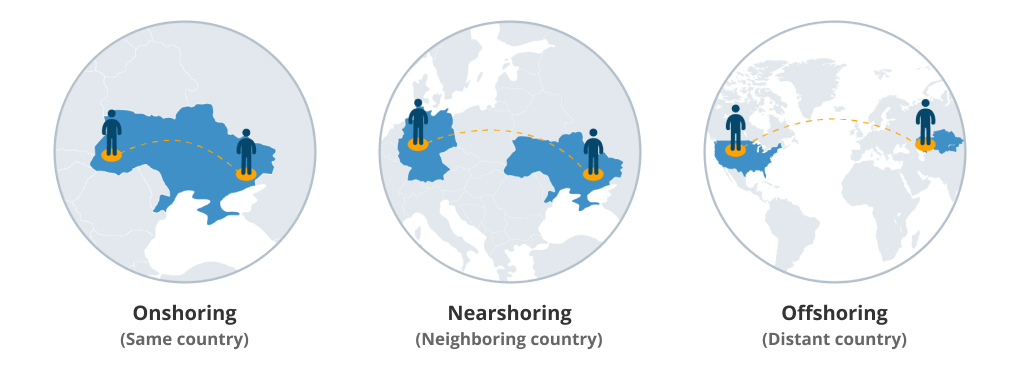Nearshoring, a business practice that has been growing in popularity in recent years, is the process of outsourcing work to a company or individual located near your own.
It has many benefits for both parties involved and can be an excellent way to improve efficiency and communication within a business.
But nearshoring is not right for every company, and there are a few things you should consider before making the decision to outsource near your home base.
What is nearshoring?
Nearshoring is the process of outsourcing work to a company or individual located near your own.
The term nearshore generally refers to outsourced work that is done in a nearby country that share a border with the country where the work is being done.
For example, a software development company in the United States might delegate projects or tasks to a software development team in Mexico. Nearshoring can also include outsourcing work to other countries in close proximity, such as Canada or Europe.

Example of nearshoring
The benefits of nearshoring
There are many reasons why the nearshoring model has become so popular in recent years. Here are just a few:
Improved communication
When you outsource work to someone near your own location, it becomes much easier for team members on both sides to communicate effectively.
There are little or no cultural differences or language barriers, and because they are either in a similar or the same time zone, you can easily arrange face-to-face meetings. This can lead to faster turnaround times.
Cost savings
Nearshoring can help save costs, as companies don’t need to invest in long-distance travel or expensive video conferencing solutions like they would if they were nearshoring overseas.
Greater flexibility
Nearshoring allows your business to be more agile and adaptive to changing market conditions, as it is easier to scale up or down quickly with nearshore partners.
Faster delivery times
Nearshore locations tend to have shorter lead times on projects, meaning that the work gets done more quickly and efficiently, making the product supply chain more efficient.
Types of businesses that use nearshoring
Nearshoring can be a great option for businesses of all sizes, from small startups to large multinational corporations. Here are some examples of companies that nearshore:
Software development
Technology and software companies outsource nearshore programming tasks to increase efficiency and reduce costs. Famous examples include IBM, Microsoft, and Oracle.
Manufacturing
Nearshoring can help reduce manufacturing costs and increase productivity. Companies such as Apple and Samsung have nearshored parts of their production processes to countries like Mexico and China.
Marketing
Nearshore partners can help companies increase the reach of their marketing campaigns quickly and cost-effectively. Companies like Nike and Coca-Cola nearshore marketing tasks to increase their global reach.
Business processes outsourcing
Businesses nearshore back-office functions such as bookkeeping, customer service, and data entry to increase efficiency. Companies like Amazon and eBay nearshore tasks related to these business operations to countries such as India and the Philippines.
Research & development
Companies nearshore R&D tasks to access specialized expertise and benefit from shorter turnaround times. Companies such as Google and Facebook nearshore research & development tasks to countries like Ukraine and Finland.
How to know if nearshoring is right for your business
Nearshoring can be an excellent way for businesses to increase efficiency and reduce costs. However, it is not the right solution for every business. Here are a few factors you should consider before nearshoring:
Your skillset
Nearshoring requires a certain level of expertise on both sides to ensure success. Assess whether your business or the nearshore partner has the necessary skills and expertise to successfully handle the outsourced tasks.
Customer expectations
Nearshoring can help speed up delivery times, but if your customers expect quick turnaround then nearshoring might not be the best option as it may take longer than they’re expecting.
Your nearshoring partner
When nearshoring, it’s important to make sure you choose a reliable and experienced nearshore partner who can handle the work you need done and that you can expect consistent quality.
It’s also wise to evaluate the reliability, experience, and cultural compatibility of potential nearshore partners to ensure a successful collaboration.
Budget
Nearshoring can save money in the long run, but there may be upfront costs involved in setting up a nearshore partnership.
Determine if your budget can accommodate any upfront costs or ongoing expenses associated with nearshoring, including fees and potential adjustments in operational expenses.
Scalability and flexibility
When thinking about nearshoring, check if it allows your business to easily adjust to changes in demand and market conditions. Can you quickly scale up or down your operations as needed?
Legal and regulatory environment
Consider any laws or rules that might affect your nearshoring activities. Think about things like protecting intellectual property and following data privacy regulations. Make sure your nearshoring arrangements comply with the necessary legal requirements.
Risk management
Take time to identify and address potential risks that come with nearshoring. Think about how to keep data secure, establish clear communication, and handle any time zone differences. By planning ahead and managing risks, you can have a smoother and safer nearshoring experience.
Cultural and communication factors
Think about the importance of cultural fit, language skills, and effective communication when working with a nearshore team. Make sure there’s a good understanding of each other’s cultures, clear channels of communication, and strong language proficiency to work together seamlessly.
Let us help you with your nearshoring needs?
If you’re looking to start nearshoring but don’t know where to start, contact us. We’ll link you with the best professionals in your region who are ready to meet your specific business needs.
Alternatives to nearshoring
Nearshoring is not the only outsourcing model when it comes to outsourcing work. There are a few other alternatives to consider, such as onshoring and offshoring.

Onshoring
Another alternative to consider is onshoring, which involves hiring employees or contractors within your own country to complete tasks.
With onshoring, you can benefit from local job creation, better control and coordination, and reduced cultural and language barriers.
However, it may not always be cost-effective compared to other outsourcing models.
The decision to onshore depends on factors such as task nature, local talent availability, cost considerations, and business goals.
Offshoring
Offshoring or offshore outsourcing is the process of hiring employees or contractors located in other countries to complete tasks for your business.
This option can be attractive for businesses looking to reduce costs, as offshore workers are typically paid less than onshore or nearshore employees.
Conclusion
In conclusion, nearshoring has many benefits for both parties involved and can be an excellent way to improve efficiency and communication within a business.
However, there are a few things you should consider before nearshoring, such as skillset, customer expectations, and budget.
Ultimately, nearshoring is a great option for many businesses – but it’s important to do your research and make sure it’s right for yours.














